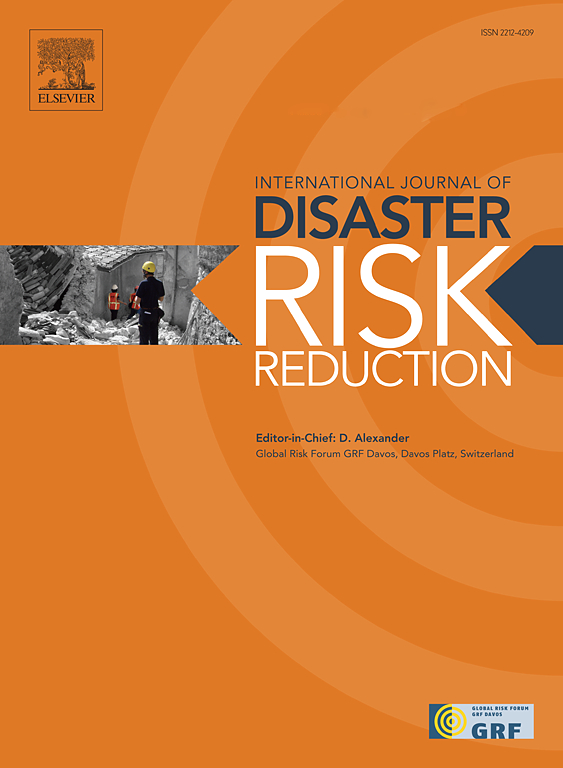Spatial Analysis of Disaster Resilience Research: A Bibliometric Study a manuscript for submission as a Review Article to International Journal of Disaster Risk Reduction by
IF 4.2
1区 地球科学
Q1 GEOSCIENCES, MULTIDISCIPLINARY
International journal of disaster risk reduction
Pub Date : 2024-10-11
DOI:10.1016/j.ijdrr.2024.104896
引用次数: 0
Abstract
We analyzed the global disaster resilience research literature to advance understanding of its geographical context. A key objective was to map the variation in disaster research resilience activity to identify hotspots and areas of less activity. The motivation is to reveal regional imbalances in resilience research and collaboration to contribute to the global narrative regarding marginalized regions. The methodology involves an in-depth examination of Web of Science (WoS) bibliographic data from 2010-2020, using keywords to develop a comprehensive perspective of disaster resilience research. Additionally, the study incorporates empirical data from the Emergency Events Data (EM-DAT) maintained by the Centre for Research on the Epidemiology of Hazards at the Université Catholique de Louvain (CRED/UCLouvain) to provide context on the impact of disasters. A key innovation of this study is the Disaster Resilience Research Score (DRRS), a quantifiable metric to evaluate the state of disaster resilience research globally by country. The DRRS considers publications, citations, and institutional involvement to provide a well-rounded view of each country's contributions to the field. The results highlight the leading role in disaster resilience research of countries including the United States, Australia, the United Kingdom, Germany, and Italy. However, there is a notable lack of research activity in countries such as Ecuador, Algeria, Kenya, Cambodia, and Myanmar, which also exhibit relatively high vulnerability to environmental hazards. Our findings indicate that countries identified as resilience hotspots predominantly collaborate within their country. This study highlights opportunities for strengthening collaborations between resilience research hotspots and locations less represented in the resilience research literature. It underscores the importance of identifying hot and cold spots to direct future research and foster a more equitable and sustainable response to climate change and hazards.
抗灾能力研究的空间分析:文献计量学研究》手稿将作为评论文章提交给《国际减少灾害风险期刊》,作者为
我们分析了全球抗灾研究文献,以加深对其地理背景的了解。一个关键目标是绘制抗灾研究活动的差异图,以确定热点地区和活动较少的地区。其动机是揭示抗灾能力研究与合作中的地区不平衡现象,从而为有关边缘化地区的全球论述做出贡献。研究方法包括深入研究 2010-2020 年的 "科学网"(WoS)书目数据,利用关键字对抗灾研究进行全面透视。此外,本研究还纳入了由卢万天主教大学灾害流行病学研究中心(CRED/UCLouvain)维护的紧急事件数据(EM-DAT)中的经验数据,以提供灾害影响的背景情况。这项研究的一项重要创新是 "抗灾能力研究评分"(DRRS),这是一个可量化的指标,用于评估全球各国的抗灾能力研究状况。DRRS 综合考虑了出版物、引用率和机构参与度等因素,全面反映了各国在该领域的贡献。研究结果凸显了美国、澳大利亚、英国、德国和意大利等国在抗灾能力研究方面的领先地位。然而,厄瓜多尔、阿尔及利亚、肯尼亚、柬埔寨和缅甸等国的研究活动明显不足,而这些国家面对环境危害的脆弱性也相对较高。我们的研究结果表明,被确定为抗灾热点的国家主要在国内开展合作。本研究强调了加强抗灾能力研究热点地区与抗灾能力研究文献中代表性较低的地区之间合作的机会。它强调了确定热点和冷点的重要性,以指导未来的研究,促进对气候变化和灾害做出更加公平和可持续的反应。
本文章由计算机程序翻译,如有差异,请以英文原文为准。
求助全文
约1分钟内获得全文
求助全文
来源期刊

International journal of disaster risk reduction
GEOSCIENCES, MULTIDISCIPLINARYMETEOROLOGY-METEOROLOGY & ATMOSPHERIC SCIENCES
CiteScore
8.70
自引率
18.00%
发文量
688
审稿时长
79 days
期刊介绍:
The International Journal of Disaster Risk Reduction (IJDRR) is the journal for researchers, policymakers and practitioners across diverse disciplines: earth sciences and their implications; environmental sciences; engineering; urban studies; geography; and the social sciences. IJDRR publishes fundamental and applied research, critical reviews, policy papers and case studies with a particular focus on multi-disciplinary research that aims to reduce the impact of natural, technological, social and intentional disasters. IJDRR stimulates exchange of ideas and knowledge transfer on disaster research, mitigation, adaptation, prevention and risk reduction at all geographical scales: local, national and international.
Key topics:-
-multifaceted disaster and cascading disasters
-the development of disaster risk reduction strategies and techniques
-discussion and development of effective warning and educational systems for risk management at all levels
-disasters associated with climate change
-vulnerability analysis and vulnerability trends
-emerging risks
-resilience against disasters.
The journal particularly encourages papers that approach risk from a multi-disciplinary perspective.
 求助内容:
求助内容: 应助结果提醒方式:
应助结果提醒方式:


